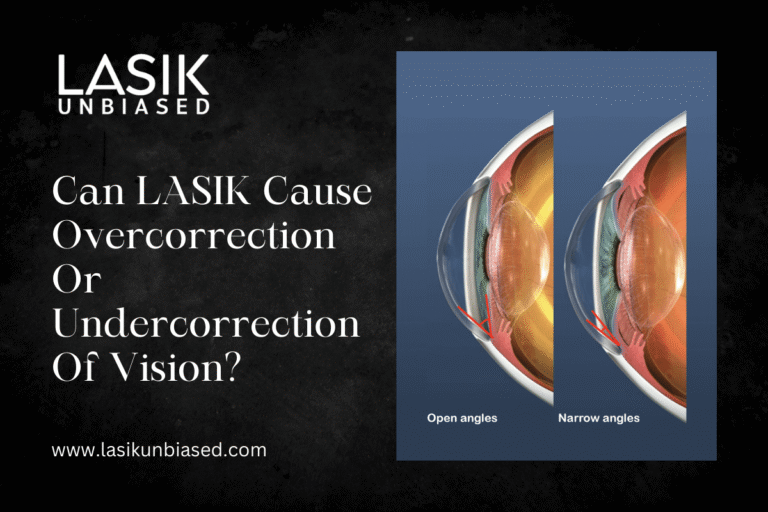Yes, LASIK can sometimes lead to overcorrection or undercorrection of vision, though these cases are relatively uncommon.
These outcomes depend on a variety of factors, including your unique eye anatomy and the precision of the procedure.
Laser-Assisted In Situ Keratomileusis (LASIK) is a popular refractive surgery that reshapes the cornea to correct vision issues like myopia, hyperopia, and astigmatism. While most patients achieve 20/20 vision or close to it, some may experience complications such as overcorrection or undercorrection. This blog explores these potential outcomes in detail to help you better understand their causes, implications, and possible remedies.
Understanding LASIK Overcorrection and Undercorrection
What is overcorrection?
Overcorrection occurs when the laser removes slightly more corneal tissue than necessary, potentially shifting the refractive error in the opposite direction—for example, turning a treated nearsighted (myopic) eye mildly farsighted (hyperopic).
Symptoms of overcorrection can include difficulty focusing on close objects, eye strain, and intermittent blurry vision. While mild overcorrection may go unnoticed or improve with time, more pronounced cases can interfere with daily visual tasks.
What is undercorrection?
Undercorrection occurs when the laser removes slightly less corneal tissue than needed to fully correct the refractive error. This results in some residual refractive error—for example, a nearsighted person may continue to experience blurred distance vision after surgery.
Symptoms of undercorrection include the persistence of your initial vision problems and a need for glasses or contact lenses to fine-tune your sight.
Why do these issues occur?
Both overcorrection and undercorrection result from the highly individualised nature of LASIK. No two eyes are identical, and despite the advanced technology used, achieving absolute precision can be challenging. Contributing factors include corneal thickness, the severity of the refractive error, individual healing patterns, and the presence of any ocular surface conditions.
Causes of Overcorrection and Undercorrection in LASIK
Individual eye characteristics
- Unique corneal structure: Very thin or irregularly shaped corneas can limit the amount of tissue that can safely be removed, increasing the risk of undercorrection or limiting eligibility for enhancement procedures.
- Severe refractive errors: Extreme cases of myopia, hyperopia, or astigmatism may be harder to fully correct, increasing the likelihood of undercorrection.
Surgical factors
- Calibration errors in the laser: Modern excimer lasers are equipped with built-in calibration and safety protocols, making calibration-related errors extremely rare, but minor deviations in laser-tissue interaction can still lead to over- or undercorrection in rare cases.
- Surgical technique: The skill and experience of the surgeon directly influence the precision of tissue removal.
Healing response
- Variable healing patterns: The cornea’s response to healing varies among individuals, potentially altering the surgery’s intended outcome.
- Regression: Most common in patients with high myopia, regression occurs when the cornea partially returns toward its original shape during healing, reducing the long-term effectiveness of the correction and potentially causing undercorrection.
Symptoms to Watch For
Signs of overcorrection
- Difficulty focusing on nearby objects, especially during reading or screen use
- Eye strain or fatigue, particularly when doing near work or in low-light conditions
- Halos or glare around lights at night
Signs of undercorrection
- Blurred vision, particularly for distances previously problematic
- Increased dependency on corrective eyewear
- A sense that the surgery “didn’t work”
By recognising these symptoms early, you can consult your ophthalmologist for a thorough assessment and timely intervention.
Note: Some visual fluctuations or mild blur are common in the first few weeks post-surgery and do not necessarily indicate over- or undercorrection. These often stabilise as healing progresses.
How Common Are Overcorrection and Undercorrection?
Studies show that the prevalence of these complications is quite low, with success rates for LASIK exceeding 95%. Advances in technology, such as wavefront-guided lasers that customise treatment to each eye’s unique characteristics, have further minimised the risk of errors.
However, mild undercorrection is slightly more common than overcorrection, as many surgeons intentionally aim for a conservative correction to preserve corneal thickness and ensure long-term eye health.
What Happens if Overcorrection or Undercorrection Occurs?
Assessing the outcome
Post-surgery evaluations are crucial for identifying and addressing any undesirable effects. Ophthalmologists perform detailed refractive tests to measure the degree of overcorrection or undercorrection.
Correcting overcorrection
- Enhancement procedures: Additional laser surgeries can fine-tune the cornea to restore balance. However, eligibility for enhancements depends on corneal thickness and other factors.
- Eyeglasses or contact lenses: Temporary corrective solutions may suffice for milder cases.
- Waiting for stabilisation: Some patients experience improvement as the eyes adjust naturally over time.
Correcting undercorrection
- Laser adjustments: Similar to overcorrection, enhancements can be performed to address residual refractive errors.
- Alternative treatments: For those ineligible for a second LASIK due to thin corneas, treatments like photorefractive keratectomy (PRK) may be viable.
- Corrective lenses: Customised glasses or contact lenses often solve minor cases of undercorrection.
Preventing Overcorrection and Undercorrection
Pre-surgery measures
- Comprehensive evaluations: A thorough analysis of your eye health, corneal thickness, and refractive error is essential to determine your suitability for LASIK.
- Choosing the right surgeon: Opt for an experienced ophthalmologist with a proven track record in LASIK procedures.
- Detailed consultations: Discuss your expectations and concerns openly to ensure you and your surgeon are aligned.
Post-surgery care
- Follow-up visits: Regular check-ups help monitor your eyes’ healing progress and detect any deviations early.
- Heeding professional advice: Strict adherence to post-op guidelines, such as using prescribed eye drops and avoiding strenuous activities, can significantly affect outcomes.
Is LASIK Safe and Worth It?
Despite the minimal risks, LASIK is an FDA-approved, safe, and highly effective procedure for most eligible individuals.
The risk of overcorrection or undercorrection is minimal when the surgery is performed by a skilled professional using modern technology. Furthermore, the vast majority of people achieve significant improvements in their vision, with many eliminating their need for corrective eyewear entirely.
If you’re considering LASIK, understanding both its immense benefits and potential risks is key. Equipped with this knowledge, you can make an informed decision and optimise your chances of success.
Take the Next Step Towards Clear Vision
While overcorrection and undercorrection are potential outcomes of LASIK, advancements in technology and meticulous planning have made these occurrences highly manageable. By consulting an experienced ophthalmologist and adhering to comprehensive pre- and post-surgery care, you can minimise the risks and enjoy the remarkable benefits LASIK offers.
If you have concerns or questions about LASIK, book a consultation with a qualified eye surgeon to discuss your options. Clearer vision might be just a heartbeat away.


